
T. melvillei spikelet.
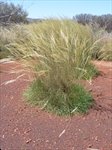
T. melvillei habitat.
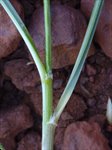
T. melvillei orifice and sheath.
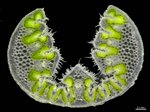
T. melvillei leaf section.
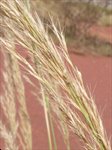
T. melvillei inflorescence.
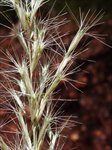
T. melvillei spikelets.

T. melvillei glumes.
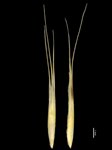
T. melvillei lemmas.
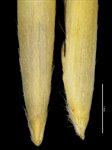
T melvillei lemma bases.
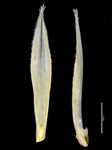
T. melvillei paleas.

T. melvillei map.
Name
Triodia melvillei (C.E.Hubb.) Lazarides
Citation
Austral. Syst. Bot. 10: 451 (1997)
Derivation
melvillei — in honour of G.F. Melville (b. 1914), an agricultural scientist in Western Australia.Common name
Melville’s Spinifex
Synonyms
Plectrachne melvillei C.E.Hubb.Diagnostic features
Foliage resinous; leaf sheath surfaces glabrous; leaf blades epistomatous (soft-type); spikelets with 3–4 infertile and reduced lemmas at the apex; lower glume 4.5–13.5 mm long, narrowly lanceolate (L:W 5.6–7.2), with 3–5 nerves; lemmas awned, uniformly textured, with hairs usually arranged in longitudinal rows (rarely appearing scattered); lowest lemma midlobe 5.5–8 mm long; palea glabrous or hairy, keels not winged; usually on loam or gravelly loam plains, less commonly on rocky hills; distribution in the Hamersley Range from Brockman mine area (near Tom Price) east to Newman, also east and south of the Pilbara.
Habitat
In the Pilbara T. melvillei usually occurs on read loam or gravelly red loam flats, (occasionally on rocky hills). South (e.g. Mt Augustus) and east of the Pilbara, T. melvillei is found only on rocky slopes.
Distribution and frequency
Widespread in central Australia. In the Pilbara region occurs only in the Hamersley sub-region (both east and west, from east of Newman to north west of Tom Price), also very sparse on rocky hills in the Gascoyne (e.g. Mt Augustus) and Little Sandy Desert regions. Pilbara populations are scattered in the landscape, but plants are usually abundant when present.
Similar species
Triodia melvillei belongs to the Soft group, sharing the epistomatous (soft-type) leaf blades. All other Pilbara species with epistomatous (soft-type) leaf blades and distinctly awned (not lobed or very shortly-awned) lemmas either have non-resinous foliage (always resinous in T. melvillei) or bitextured lemmas (uniformly textured at maturity in T. melvillei).
Triodia pisoliticola is similar but has non-resinous, lax and usually drooping leaves 24–59 cm long (15–35(–46) mm long in T. melvillei), 0–2 reduced infertile florets terminating spikelets (3–4 reduced infertile florets at the apex of spikelets in T. melvillei), and occurs in the west Pilbara, disjunct from the distribution of T. melvillei.
Triodia avenoides, T. basitricha, T. schinzii, T. degreyensis and T. sp. Mt Ella all have bitextured lemmas (uniformly textured in T. melvillei) and hairs uniformly distributed over the surface of the lemma (usually in distinct longitudinal rows in T. melvillei).
Triodia karijini has non-resinous or very weakly resinous foliage (strongly resinous in T. melvillei), smaller, more densely tufted culms (culms hummock forming in T. melvillei), and lemma lobes narrowly acute to sub-awned (distinctly awned in T. melvillei).
Triodia veniciae has hairy leaf sheaths (glabrous in T. melvillei), lemma lobes narrowly acute to sub-awned (distinctly awned in T. melvillei), and occurs in the Chichester sub-region (Hamersley, Gascoyne or Little Sandy Desert regions for T. melvillei).Conservation status
Not considered at risk.
Identification without florets
The epistomatous (soft-type), resinous leaves, narrowly lanceolate glumes, and distribution in the Hamersley (East and West), Gascoyne or Little Sandy Desert regions exclude all other species except T. schinzii and T. sp. Mt Ella. Triodia schinzii occurs on sand and has 7–11 glume nerves (3–5-nerved in T. melvillei). Triodia sp. Mt Ella occurs on rocky slopes and gullies (T. melvillei is usually on flats in the Pilbara), has longest basal pedicels 5–15.5 mm long (1.6–6.5 mm long in T. melvillei) and usually fewer florets (28–84) in the inflorescence (compared to 57–286 in T. melvillei).
Variation
Habitat variation is noted above. The length of the lemma awns can vary somewhat. Hairs on the lemma body are usually in distinct longitudinal rows, but very occasionally appear to be scattered over the lemma surface.
Notes
The concept of T. melvillei in Lazarides (1997), Lazarides et al. (2005) and Ausgrass (Sharp & Simon, 2002; Simon & Alonso, 2014) included the forms now named as T. pisoliticola (noted as a non-resinous variant), however the descriptions therein are based almost entirely on T. melvillei (other than the noted non-resinous variant).